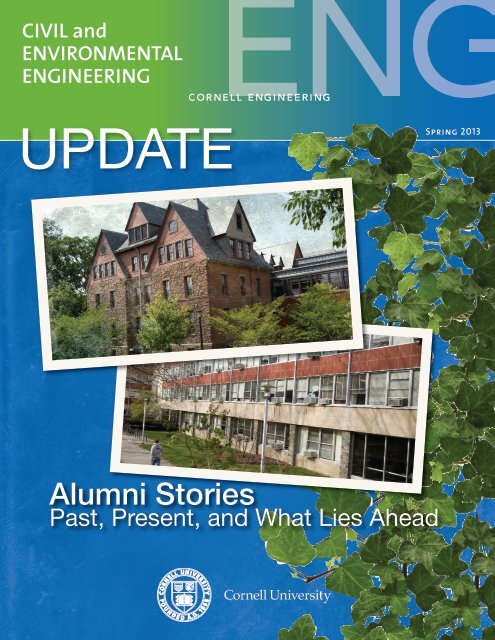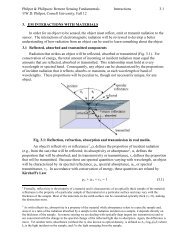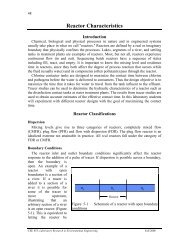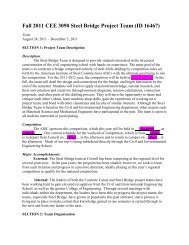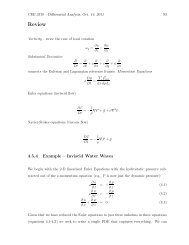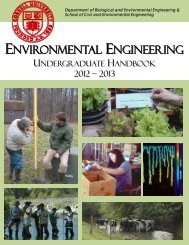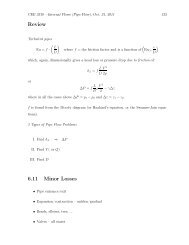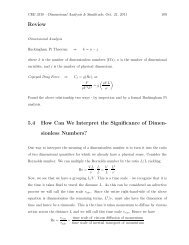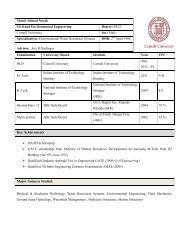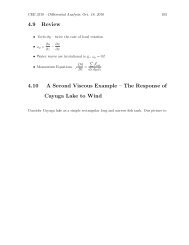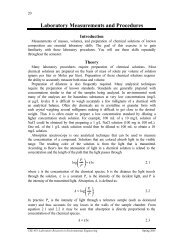Spring 2013 - Civil & Environmental Engineering - Cornell University
Spring 2013 - Civil & Environmental Engineering - Cornell University
Spring 2013 - Civil & Environmental Engineering - Cornell University
- No tags were found...
You also want an ePaper? Increase the reach of your titles
YUMPU automatically turns print PDFs into web optimized ePapers that Google loves.
CIVIL andENVIRONMENTALENGINEERINGUPDATE<strong>Spring</strong> <strong>2013</strong>Alumni StoriesPast, Present, and What Lies Ahead
FROM THEDirectorCEE UPDATE is published oncea year by the School of <strong>Civil</strong> and<strong>Environmental</strong> <strong>Engineering</strong>,<strong>Cornell</strong> <strong>University</strong>, Ithaca, New York.Director:Philip L.-F. LiuDirector of Administration:Joe RoweNewsletter Production Coordinator:Jeannette L. LittleEditor:Katelyn GodoyWriters:Gary E. Frank and Sarah L. SmithDesigner:Valerie McMillenPhotographs:Jeannette L. LittleMichelle Kim<strong>Cornell</strong> <strong>University</strong> PhotographyPrinted on recycled stock.Produced by<strong>University</strong> Communicationsat <strong>Cornell</strong> <strong>University</strong><strong>Cornell</strong> <strong>University</strong> is an equalopportunity, affirmative actioneducator and employer.4/13 4.9M EL 130192<strong>Spring</strong> <strong>2013</strong>On the cover: Lincoln Hall and Hollister HallPhil LiuDear alumni and friends,This issue’s main feature is a collection of eight stories of alumni whograduated between 1949 and 2010. We asked them to recall some of thehighlights of their <strong>Cornell</strong> CEE experience and their career. I hope that youfind their stories interesting and perhaps they will trigger some of your ownmemories. If so, please feel free to write down those memories and sendthem to us. We would love to read them.For many of you, this newsletter will be the first time you have heard aboutthe passing of Professor Bill McGuire. Bill died peacefully on January 31,<strong>2013</strong> surrounded by family members. Until the end of his life, he kept intouch with alumni, faculty, and staff on a regular basis. Bill was 92 years old.During the last year we have been working very hard in addressing twochallenging issues: faculty renewal and the renovation of laboratory facilities.Based on our faculty demographics, we anticipate that more than one-thirdof our faculty will either retire or enter a phased retirement agreement in thenext five to seven years. We are developing and implementing a strategicplan to replace these highly accomplished senior faculty members in a timelyand effective manner. Our strategic plan also addresses the need to updateour laboratory facilities.At the time of last year’s newsletter, we were conducting three facultysearches. I am very pleased to report that we were successful in findingthree new, outstanding faculty members. Two of them, one in structuralengineering and the other in environmental and water resource systems,will join us in fall <strong>2013</strong>. The third new faculty member, whose research andteaching focus is in environmental processes, will arrive in spring 2014. Weare very excited to have them on board and will highlight them in next year’sCEE Update.We are currently conducting two new faculty searches. One istaking place here on the Ithaca campus in the area of structural and/orgeomechanical behavior across materials and time and length scales. Thesecond search aims to fill a position at the <strong>Cornell</strong> NYC Tech campus. Thissearch is very broadly defined and is focused in the applied informationscience area of the built environment. We anticipate a few more facultyopenings in the built environment area at <strong>Cornell</strong> Tech in the near future.To attract new faculty members who are doing cutting-edge researchand meet higher standards, it is essential to upgrade and renovate ourexisting wet and dry laboratory facilities. A larger renovation project, the<strong>Environmental</strong> Processes Complex inside Hollister Hall, has been approvedas part of the College of <strong>Engineering</strong>’s five-year facility plan. We will needyour support to make this come to realization.In the fall, we will once again welcome a new group of students. Ourfaculty and staff members are looking forward to helping them meet theireducational goals. Today's students use social media to stay connected,and CEE is now on Facebook, LinkedIn, and Twitter. I encourage you to stayconnected with us, too, and send us your news. We enjoy hearing from ouralumni and friends, and (as I mentioned above) we are always glad to hearabout your CEE memories.Sincerely yours,Class of 1912 Professor and CEE DirectorJames W. Spencer ’49, MCE ’51Professor emeritus of biological and environmental engineeringWhile digging a ditch for a public works job the summer after hegraduated from Ithaca High School, James W. Spencer realizedwhat he wanted to do with his life.“I spent enough time in the ditch that I thought things would bemore interesting on top of it, so I had the notion of becoming a civilengineer,” says Spencer.After a rough start academically, Spencer graduated in 1949and was immediately offered a position as an instructor in civilengineering. While in graduate school, two years later, he wasinvited to join the faculty in agricultural engineering as an assistantprofessor. These positions marked the beginning of Spencer’s 38-year career at <strong>Cornell</strong>—during which he never actually applied fora job.It was the late Donald Belcher, widely regarded as the father ofair photo interpretation, who offered Spencer the first job he had at<strong>Cornell</strong>.“He was one of the best teachers I ever had,” says Spencer. “Younever got just a ‘what’ from him. You got a ‘what’ and a ‘why.’”Belcher made such an impression on Spencer that he chose tominor in education while working toward his master’s degree, hesays, “to try to learn something about the learning process andabout what made Don Belcher such an effective teacher.”Others may want to learn something about what made Spencerhimself both an effective teacher and administrator during his timefeatureQuality, Diversity of CEE ProgramSpans DecadesEight alumni of the School of <strong>Civil</strong> and <strong>Environmental</strong> <strong>Engineering</strong>’s undergraduate and graduate programs were asked to discussthe school’s impact on their lives and professions. Although each alumnus or alumna graduated in a different decade since theend of World War II, they all share a common esteem for CEE. Each person, whether having graduated in the 1940s or the 2000s,expressed how the school’s faculty members were top-notch. And, more importantly, how they were demanding—yet fair—andoften inspirational.at <strong>Cornell</strong>. He is renowned for the high level of commitment, care,and discipline he brought to everything he did.In addition to conducting research and teaching local roadimprovement in the College of Arts and Sciences, Spencer alsoserved as the college’s associate dean and the vice director of<strong>Cornell</strong> Cooperative Extension. At the university level, he servedbriefly as special assistant to the president and then as vice provost.Among some of his other jobs along the way was his time spentassisting Belcher in exploring soil characteristics of possible sitesfor Brasilia (the capital city of Brazil). Not a bad resume for someonewho admits his academic performance was less than stellar whenhe was a first-year student. That includes failing chemistry.“I took it again,” says Spencer. “Things went well, and I havenever regretted having chosen civil engineering as a career.”Thomas Nuttle ’51Retired businessmanThomas Nuttle came to <strong>Cornell</strong> in 1947, and thanks to a fewextra college credits he earned in high school, he completed hisfive-year civil engineering degree in four and a half years. During histime at <strong>Cornell</strong>, he was an All-American lacrosse player and wasthe team captain his senior year, which earned him induction intothe <strong>Cornell</strong> Hall of Fame in 2012. Nuttle was also elected to the TauBeta Pi engineering honor society in his senior year.Like James Spencer, Nuttle regards himself very fortunate tohave crossed paths with Donald Belcher.2 CEE Update <strong>Spring</strong> <strong>2013</strong>James W. Spencer ’49, MCE ’51 Thomas Nuttle ’51CEE Update <strong>Spring</strong> <strong>2013</strong> 3
featurefeatureKatherine Anne Weible ’10 David Goodyear ’73, MEng ’74“He was doing a lot of aerial identification of different problemsand solutions, and it worked out well,” says Nuttle, who wasBelcher’s assistant.Within a month after he graduated, Nuttle was serving in theKorean War with the Second Infantry Division. Eight months later,after leaving active duty, he returned to the United States and wentto work for an engineering consulting firm in Baltimore.“But I soon learned I did not like consulting,” Nuttle recalls. So heshifted his focus and found a family-owned company in Baltimorethat dealt with building materials such as stone, ready-mixconcrete, and blacktop.“Two members of the family had attended <strong>Cornell</strong>, so they took achance with me,” he says.Nuttle believes, above all, he was hired because his employersknew that <strong>Cornell</strong> graduates are able learners.“All of a sudden I had to work with equipment that I knew nothingabout. I was making little rocks out of big rocks. But I felt veryconfident in doing it.”Despite several changes in the company’s ownership, Nuttleeventually became its chief executive officer. He retired in 1992 andstill resides in Baltimore.“<strong>Cornell</strong> has a very strong, nationwide position in engineering. Ifyou have an engineering degree from <strong>Cornell</strong>, it’s respected andthat gives you an advantage,” says Nuttle. “It worked very well forme. I got to be CEO of a company.”Katherine Anne Weible ’10<strong>Environmental</strong> engineer at URS CorporationKatherine Anne Weible would agree with Thomas Nuttle that theeducation she received in the School of <strong>Civil</strong> and <strong>Environmental</strong><strong>Engineering</strong> helped her “learn how to learn.”“<strong>Cornell</strong> definitely makes you a really good learner and that, Ithink, has been key in my job because I didn’t have a remediationbackground,” says Weible. “But I knew how to be a good studentand how to learn things quickly.”Weible works for URS Corporation’s remediation services unit,which cleans up nuclear and toxic waste sites.4 CEE Update <strong>Spring</strong> <strong>2013</strong>“When I graduated I felt confident that I had gotten a goodeducation and that it had . . . prepared me for the real world,” saysWeible, who was a member of the AguaClara team and Engineersfor a Sustainable World at <strong>Cornell</strong>. “Even though CEE didn’t provideme with the perfect background for this kind of job, it did provideme with a strong background for being a good student, . . . a goodworker, and a good team member.”Weible recommends CEE to prospective civil and environmentalengineers without any hesitation, and she praises the school’sfaculty, especially Monroe Weber-Shirk.“I know that my time spent with Monroe Weber-Shirk wasbeyond valuable. I’m so thankful for that. It kept me from strayingaway from civil engineering,” she says. “Coming out of collegeI thought, ‘I don’t have to have an engineering job; I could dosomething else for a while.’ But I really felt compelled to continue init largely because of his influence.”David Goodyear ’73, MEng ’74Senior vice president and chief bridge designer atT.Y. Lin InternationalOne of the most respected and renowned bridge designers inthe country, David Goodyear remembers a lesson that fell outsidethe engineering curriculum but nevertheless made a lastingimpression.“Professor Nilson was the only one who graded my grammaron an engineering exam. At the time we were all aghast, but hedid it for a reason,” says Goodyear. “One of the real advantages ofattending <strong>Cornell</strong> is the diversity of opportunity you have there . . .to reach out beyond the engineering school.”For Goodyear, that meant taking courses in economics, politicalscience, and even literature.“You don’t get projects funded by other engineers; you get themfunded by politicians and administrators,” says Goodyear, whoserecent project list includes the Hoover Dam Bypass Bridge. “Youneed to be able to communicate the merit of what you’re doing.. . . It’s important to do that at least with reasonable effectivenessor you end up not having many projects.”Walter J. R. Buydens, PhD ’92 Donna Fennell, MS ’88, PhD ’98Goodyear regards CEE’s structural engineering professors asbeing the most influential, particularly William McGuire.“Ever since I graduated I’ve come to appreciate the quality ofeducation and the approach the professors took to engineeringeducation,” says Goodyear. “The focus on fundamental behaviors,. . . material science, and material behaviors, as opposed to rotememorization of codes and standards, really broadens the horizonsof an engineering student. I hope the approach to engineeringeducation is the same now as it was then, because it was certainlyvery good back then.”Walter J. R. Buydens, PhD ’92Country director at Royal Haskoning DHV, QatarMuch of Walter Buydens’s work, similar to that of DavidGoodyear, involves dealing with those who set public policy. InBuydens’s case, it is in Qatar, which is a nation of 1.8 million peoplewith only 250,000 Qatari citizens; it has both the world’s highestGDP and largest carbon footprint per capita.“The country has an environmental minister who is very seriousabout his job, and the ministry includes many people who werewell educated in England and the United States,” says Buydens.He explains the ministry is trying its best to reduce the carbonfootprint, but the population is hesitant to take the necessary stepsand thus progress in reducing the footprint is slow.A common theme of Buydens’s graduate school experience atCEE was resource optimization.“You had linear programming, dynamic programming . . . allthese helped me to gain insight into how you can mathematicallyoptimize problems; but first, how you define problems in amathematical way,” says Buydens.He regards Professor Christine Shoemaker, his thesis advisor, asa very influential faculty member. He says he admires her becauseher teaching was so practical.“In the case of dynamic programming, Christine Shoemakeralways said: ‘This is the way we should look at life. It doesn’t matterwhat is behind us; the main thing is to look at what’s in front of youand how to get there in an optimal way.’”Donna Fennell, MS ’88, PhD ’98Associate professor of environmental science atRutgers <strong>University</strong>If there is one aspect of Donna Fennell’s experience at CEE thatmade the biggest impression on her, it was how much the facultycollaborated with scholars from other disciplines.“The faculty [was] very supportive of a broad, interdisciplinaryscience education that went along with the higher-level engineeringcourses you were taking. So, civil and environmental engineeringis an exciting field because you are constantly incorporating newscience that comes along and looking for ways to include the bestscience in problem solving,” says Fennell, who also earned an MSin agricultural engineering at <strong>Cornell</strong>.Since leaving <strong>Cornell</strong>, Fennell says her work has always includedpeople from other disciplines.“I think a degree in civil and environmental engineering really setsyou up very well to enter new areas, because you get that exposureto science and learn how to incorporate it into engineering problemsolving,” says Fennell.“Looking back, the thing I remember from the courses is thatthey were extremely challenging and I learned so much. Later on Ihad the opportunity to be a teaching assistant for a couple of thecourses, so I really had to gain a fundamental knowledge of thematerial because I had to grade homework and figure out all theways a problem could be solved (or messed up!),” she says.Fennell says she “can’t overstate” how much Professor JimGossett, her thesis advisor, continues to influence her approachesto teaching and research.“He is not only extremely brilliant—I learned a lot of facts fromhim and a lot of methods from him—but also has very highstandards,” she says. “With everything I do now, in the back ofmy mind there’s always, ‘what would Jim say about this? Whatwould he think about it, and would it be up to his expectations?’ It’salways something that drives what I do.”CEE Update <strong>Spring</strong> <strong>2013</strong> 5
Ting Lin ’06Postdoctoral fellow at Stanford <strong>University</strong>’sJohn A. Blume Earthquake <strong>Engineering</strong> CenterTing Lin says her experience as an undergraduate in CEE lit apassion within her that burns fiercely to this day.During her first summer at <strong>Cornell</strong>, Lin noticed how busy PeteLoucks (now a professor emeritus) was.“He was teaching class, guiding graduate students, and doingresearch in several different areas. I asked him how he managedit, because he basically didn’t have any holidays at all the firstsummer I was at <strong>Cornell</strong>,” she says. “The answer he gave me was‘life is a holiday’ and I came to realize that as long as you love whatyou are doing, every day is a holiday. That has helped to sustain mypassion for almost a decade now.”During her sophomore year, professors Thomas O’Rourke, HarryStewart, and Michael Palmer invited Lin to join their team doingresearch on lifeline earthquake engineering.These professors got Lin very interested in research, whichencouraged her to go to graduate school, take a position as apost-doc, and consider joining academia in the future.“Their passion for research was inspiring. They taught me notonly how to do research but also how to advise students. Now it’smy turn and I really want to be able to pass on that passion andencourage more students to become engineers and contribute toour profession.”Lin says Ezra <strong>Cornell</strong>’s quote, “I would found an institution whereany person can find instruction in any study,” also motivated her toventure out and take courses outside of CEE.“That really broadened my perspective and helped me to realizewhat our role as civil engineers is and how it connects to otherfields,” says Lin, who earned a concentration in architecture.“<strong>Cornell</strong> has a very strong architecture program, so if students cantake advantage of that, they benefit from the logical thinking ofengineering and from the creative side of the architecture program.”6 CEE Update <strong>Spring</strong> <strong>2013</strong>featureTing Lin ’06 David Darwin ’67, MS ’68David Darwin ’67, MS ’68Deane E. Ackers Distinguished Professor in the Departmentof <strong>Civil</strong>, <strong>Environmental</strong>, and Architectural <strong>Engineering</strong> at the<strong>University</strong> of KansasDavid Darwin’s professional life began because of an encounterwith a “good guy” when he was taking his first-year, introductoryengineering course.“During freshman year, seminar sections in Introduction to<strong>Engineering</strong> were always taught by tenure-track faculty members.I happened to be assigned to a seminar taught by a civil engineer,”recalls Darwin. “When you’re a teenager and you’re trying to decidewhich direction to go, sometimes one person can have a big impactand help you decide what path to take. George H. Blessis, assistantprofessor of civil engineering, was the person who did that for me.”By his junior year, Darwin says he was “knocked over” by thequality of the civil engineering faculty. People like Peter Gergely,Richard White, and William McGuire were “giants of their field” hesays, “and they were teaching us undergraduates.”“The career preparation <strong>Cornell</strong> provided was superb. Betweenmy bachelor’s and my master’s, I got a really good grounding inthe fundamentals and in some of the advanced areas of structuralengineering,” says Darwin.After serving four years with the Army Corps of Engineers, Darwinentered the <strong>University</strong> of Illinois to work toward his doctorate and feltas well prepared, or better prepared, than his classmates despitebeing away from academia for four years.Darwin thinks it was a wise, strategic move to add “environmental”to the school’s name, a change that occurred after he graduated.“When communicating with the public, one of our problems ascivil engineers is the adjective that goes with “engineering” in ourtitle,” says Darwin. “You have to explain that you’re a structuralengineer, geotechnical engineer, transportation engineer, waterresources engineer, or environmental engineer. ‘<strong>Environmental</strong>’adds just a little bit more of a description of what is available in thecurriculum. At <strong>Cornell</strong>, this has helped attract more students to theschool. All fields within civil engineering are reaping the benefit.”International Student Studyand Experiential LearningCEE students share knowledge abroad and at homeFrom Honduras to Nicaragua or fromSpain to China, the School of <strong>Civil</strong>and <strong>Environmental</strong> <strong>Engineering</strong>offers international experiences to studentsthrough a variety of exchange and researchprograms.In Honduras, CEE students in the groupAguaClara partner with Agua Para ElPueblo, a Honduran nonprofit, and workwith local communities to develop andimprove sustainable water treatment. Ledby Monroe Weber-Shirk, senior lecturer incivil and environmental engineering, theteam developed a suite of water treatmenttechnologies ideally suited to rural areasof the country. These gravity-powered,electricity-free systems fit the populationand financial needs of any communityby providing a simple, low-cost watertreatment solution.Currently seven systems serve30,000 Hondurans, but AguaClara’slong-term goal is to develop and sharethese high-performing, low-cost,reliable, and sustainable technologieswith nongovernmental organizations,governments, and private engineering firmsin the developing world. As a result, theAguaClara research team was honoredwith the 2012 Katerva Award in the urbandesign category. This distinguished awardhighlights the world’s most promisingsustainability ideas and honors the bestsustainability innovators.Talented students are also on the SolarCooker Project (a part of Engineers fora Sustainable World) and continue towork to increase the use of solar ovens inNicaragua. Working with Grupo Fenix, anorganization at the Universidad Nacionalde Ingeneria in Managua and Las MujeresCEE-<strong>Cornell</strong> China Exchange Programstudents (left to right) Kaijun Zhu, Da Yi, andJian CuiglobalSolares de Totogalpa, a women’s collectivein Sabana Grande, the team advocates forthe increased use of solar cookers.These solar cookers provide thepeople of Nicaragua, and potentially othercountries, with an inexpensive, sustainable,and simple alternative to wood-firedcooking. Students in the ESW SolarOven Project class worked on a foldable,portable, lightweight cooker; a lightweightbox cooker; and a water distiller thissemester. Of the 22 students in the class,eight traveled to Las Mujeres and GrupoFenix in Sabana Grande, Nicaragua, overtheir spring breaks to assemble the cookersand a water purification distiller and usethem with the Nicaraguans.Unlike the brief international visitsAguaClara and the Solar Cooker teamsmake, the <strong>Cornell</strong>-Cantabria ExchangeProgram (CCEP) offers a longer-termexperience for CEE students. Studentsspend their junior year immersed inSpanish at the Universidad de Cantabriain Santander, Spain. Each group of<strong>Cornell</strong>ians pairs up with a group ofUniversidad de Cantabria second-yearengineering students. The groups completethe exchange program when the Spanishstudents who partnered with the <strong>Cornell</strong>students spend their third year in Ithaca.The CCEP was not only designed toprovide engineers with global skills, butalso to help them understand Spanish,an increasingly valuable skill to have inthe United States. Recognized by theInternational Institute of Education as anoutstanding international higher educationinitiative, the program allows studentswith solid high school backgrounds inthe Spanish language to take the College<strong>Cornell</strong>-Cantabria exchange students (left to right)Sergio Lorenzo Llarena, Jorge Gorrochategui Ruiz,Irene Medina, Clara Coromina Nestares, MikelMartin Santiago, and Ivan Toribio Sanchezof <strong>Engineering</strong>’s curriculum-approvedcourses, primarily in English, whilestudying at the Universidad de Cantabria inSantander, Spain, for a full academic year.CEE’s newest international program, theCEE–<strong>Cornell</strong> China Exchange Programwith Southwest Jiaotong <strong>University</strong>, beganwith its first students arriving on campus inthe fall of 2012. Because five of SouthwestJiaotong <strong>University</strong>’s previous presidentshad been <strong>Cornell</strong> graduates, its currentpresident and a delegation visited <strong>Cornell</strong>in 2011 to express a strong interest incollaborating with <strong>Cornell</strong>’s academics,teaching, and research. While there isno research collaboration established atthis time, Southwest Jiaotong <strong>University</strong>students have the opportunity to cometo <strong>Cornell</strong> to contribute academicallyand socially, interact with the professors,and learn about Ivy League teachingphilosophies.Like the Chinese students, three newundergraduate students from Brazil arestudying in CEE for the <strong>2013</strong> academic yearalong with 24 other Brazilians who cameto study at <strong>Cornell</strong> under the auspices ofAcademic do Brazil em <strong>Cornell</strong>. This pilotprogram is part of an initiative that expandseducational opportunities for Braziliancitizens and is funded by the Braziliangovernment’s Ciência sem Fronteirasprogram.While the Brazilian students learn from<strong>Cornell</strong>ians, their presence further helps tointernationalize the campus and broadenthe horizons of <strong>Cornell</strong> students who maynot be able to travel abroad.For those students who can studyoverseas, CEE offers a wide range ofexciting opportunities around the world.Brazilian students (left to right) Marlon Passos,Marina Servino, and Hugo LimaCEE Update <strong>Spring</strong> <strong>2013</strong> 7
in memoriamCEE Professor Emeritus William McGuire, NAEby J.F. Abel with R.D. ZiemianThe School of <strong>Civil</strong> and<strong>Environmental</strong> <strong>Engineering</strong> lostone of its most distinguishedfaculty members when ProfessorEmeritus William McGuire died onJanuary 31, <strong>2013</strong> at the age of 92.In 1994, he had been elected to theNational Academy of <strong>Engineering</strong>and was also named a DistinguishedMember of the American Society of<strong>Civil</strong> Engineers.McGuire was born in Staten Island,New York. After receiving a BSCE degree from Bucknell <strong>University</strong>in 1942, he served in the U.S. Navy in the Pacific as an aircraftmaintenance officer on the aircraft carrier U.S.S. Franklin. Thosewho came to know McGuire later in his life realized that his intenseexperiences of three years in the wartime navy remained stronglywith him, especially the disastrous bombing of the Franklin onMarch 19, 1945, just 50 miles off the coast of Japan, that resultedin the death of more than 800 crew members, although the carrieritself remained afloat despite raging fires.8 CEE Update <strong>Spring</strong> <strong>2013</strong>While on active duty in the navy, McGuire courted and marriedBarbara Weld, and they celebrated their 65th anniversary justmonths before she died in 2009. Two sons, Robert McGuire ofIthaca and Thomas McGuire of Tucson, two granddaughters, andtwo great-grandsons survive them.Following World War II, McGuire earned an MCE degree instructural engineering at <strong>Cornell</strong> while having his first opportunitiesto serve as an instructor of undergraduate courses. In 1947, heworked for Jackson & Moreland Engineers, Boston, as a structuraldesigner of power plants and atomic energy projects. In 1949, heaccepted George Winter’s invitation to join the structures facultyin CE at <strong>Cornell</strong>. He was promoted to associate professor in 1952and then to professor in 1960, served as director of the schoolfrom 1966 to 1968, and was named professor emeritus after40 years of service in 1989. In that time, he also spent periodsas a visiting faculty member at the Asian Institute of Technology(Bangkok), the <strong>University</strong> of Canterbury, the <strong>University</strong> of WesternAustralia, the <strong>University</strong> of Tokyo, the <strong>University</strong> of Liege, and theStrathclyde <strong>University</strong>.His professional interests were primarily in the area of steelstructures, and his early research on such topics as connections,William McGuire in the 1960s during his time as director of the School of <strong>Civil</strong> and <strong>Environmental</strong> <strong>Engineering</strong>welding, and fatigue culminated in his classic textbook, themonumental and influential Steel Structures (1968). Startingin the 1970s, his interests evolved to progressive collapse ofstructures, nonlinear analysis and design, and nonlinear torsionalflexuralbehavior—all connected to innovations in the applicationof interactive computer graphics techniques to computationalstructural analysis and design. Through the 1970s and 1980s, hissupervision of graduate theses exhibited a marked upswing, andhis students from that era have distinguished themselves by fillinga number of faculty positions, deanships, and one presidencyat leading institutions or by undertaking successful careers instructural design. In addition to authoring—or co-authoring withhis students and colleagues—numerous papers, McGuire was thesenior author of two editions of the widely used textbook, MatrixStructural Analysis (1979 with R.H. Gallagher; and 1999 with R.H.Gallagher and R.D. Ziemian).McGuire’s teaching, mentoring, research, writing, and consultingearned him wide respect from his students, faculty colleagues,and those in the wider structural engineering profession. He wasinvited as a keynote speaker at several national and internationalconferences and he delivered seminars at dozens of American andforeign universities. McGuire served on several national committeesrelated to the specifications for design of steel structures, includingthe ASCE A7 Task Committee on General Provisions (1975–1990),the American Iron and Steel Institute Subcommittee on Weldingof Cold Formed Steel (1975–1985), and the American Institute ofSteel Construction Specification Committee (1985–1991). He wastwice a winner of the annual ASCE Norman Medal for co-authoringthe paper that makes a definitive contribution to engineering (withG.P. Fisher in 1962; and with R.D. Ziemian and G.G. Deierlein in1994). Among his other recognitions were the ASCE’s ShortridgeHardesty Award in 1992, the AISC’s 1992 T.R. Higgins Lectureshipand 2000 Geerhard Haaijer Award, and the Structural StabilityResearch Council’s 2005 Lynn S. Beedle Award. Within <strong>Cornell</strong>, theundergraduate Chapter of Chi Epsilon selected him as Professor ofthe Year in 1979.McGuire’s consulting as a licensed professional engineerincluded the design of special structures and the investigation of anumber of structural failures, including such notables as the HyattRegency walkway collapse in Kansas City (for NBS/NIST) and theL’Ambiance Plaza collapse in Bridgeport, Connecticut (for OSHA).McGuire was one of the very few engineers who were selected andserved as independent reviewers of FEMA’s post 9/11 report titledWorld Trade Center Building Performance Study: Data Collection,Preliminary Observations, and Recommendations. He had alongtime involvement on behalf of <strong>Cornell</strong> in the planning, design,upgrading, and maintenance of the large radio telescope structureof the National Astronomy and Ionosphere Center, Arecibo, PuertoRico. He was also co-designer (with S.C. Hollister) of the Fall CreekSuspension Bridge on the <strong>Cornell</strong> campus.His colleagues remember McGuire as a true gentleman, an avidreader, especially of nonfiction, and a wonderful conversationalistwho invoked history, travel, politics, and current news in addition towhat he termed his “sea stories,” much of which had nothing to dowith the navy. For the current <strong>Cornell</strong> CEE faculty, he was the solesource of tales of when the school inhabited Lincoln Hall before itsmove to Hollister Hall in 1959. For many individuals, McGuire has asignificant place in their fond memories of <strong>Cornell</strong>.MemorialGathering onSeptember 7CEE will host a memorialgathering on Saturday,September 7, <strong>2013</strong> tocelebrate ProfessorWilliam McGuire’s life andachievements. All arewelcome, and furtherinformation will be posted onthe CEE website,www.cee.cornell.edu, byearly summer.Memorial GiftsFor those wishing to makea memorial contribution,please consider giving tothe William McGuire Masterof <strong>Engineering</strong> Fellowship inthe School of CEE that wasestablished when he retired.Gifts in Bill's honor can be made bycheck, payable to <strong>Cornell</strong> <strong>University</strong>with memo “McGuire Fellowship” andmailed to CEE; or by credit card onthe CEE website: Alumni > Give to CEE> Click here to donate > under “otherdesignation or special instructions”please enter McGuire Fellowship.CEE Update <strong>Spring</strong> <strong>2013</strong> 9
student spotlightsstudent spotlightsJamal Cherry of Tampa,Florida is a junior in civilengineering whose interestslie in the energy sector. Insummer 2012 he internedin Ghana, West Africa withthe region’s largest energycompany, Volta River Authority(VRA). Cherry’s goal is to helpdevelop technologies thatincrease the efficiency andsafety of both conventional andunconventional oil extractionmethods. He hopes to deviseinnovative techniques todecrease the environmentalimpact of such extractionmethods. Cherry is specificallyinterested in the process ofhydraulic fracturing (fracking),its interactions with theenvironment, and how to makeit as environmentally safe aspossible while maximizing profit.Michael Hyland of Pittsburgh,Pennsylvania earned abachelor’s degree in civilengineering in May 2012.After graduating, he decidedto stay at <strong>Cornell</strong> to pursue amaster of engineering degreein transportation systemsengineering. In his researchwith Professor Mark Turnquist,Hyland has developed amodel to determine facilitylocations that meet uncertaindemand. The model balancesoverall costs and coveragerequirements and combinesscenario-based planning foruncertainty with coveragerestrictions (for example,a specified portion of totaldemand must be within a fixeddistance of a facility). Thiswork represents an importantadvance in the field of locationmodeling for transportationsystems that provide logisticsservices.Erika Johnson of Catonsville,Maryland came to <strong>Cornell</strong> topursue a PhD in environmentalfluid mechanics and hydrology.Her interests are in turbulenceand environmental fluid flow.Her ultimate goal is to obtaina faculty position. Johnson’sresearch focuses on developinga methodology to improve theU.S. Geological Survey (USGS)process of river gaging, whichmeasures volumetric flowrate at approximately 7,000locations in our nation’s riversand streams. The currentUSGS method of determiningvolumetric flow rate involvespoint measurements of rivervelocity spanning the width anddepth of the river. Johnson’sproposed technique involvesimaging the river’s surfacethrough the use of remotesensing technology andapplying turbulence theory todetermine volumetric discharge.Her advisor is Professor EdwinCowen.Jonathan Lamontagne ofDeerfield, New Hampshireis an MS/PhD student inenvironmental and waterresource systems. Lamontagnehas two primary areas ofongoing research. The firstconcentrates on improvingflood risk estimation techniquesand could be broadly describedas flood frequency analysis.The second area is hydropoweroperations optimization,which involves the design ofalgorithms to optimally use finitewater resources as generatorsof electricity in the face ofuncertain weather and energyprices. Lamontagne’s advisor isProfessor Jery Stedinger.Sarah Levine of Beachwood,Ohio is a junior who is pursuingan environmental engineeringdegree. Levine decided toenhance her educationalexperience by taking classeslike engineering economics,earth science, and energysystems, which are not partof the standard curriculum.Outside of the classroom, herprimary work is with <strong>Cornell</strong><strong>University</strong> Sustainable Design(CUSD), an interdisciplinary,student-led, design-buildproject team. The groupfocuses on realizing a futureof economic, social, andecological sustainability. Levineco-leads a team of roughly 25students that is working on twoCUSD design projects. For oneof them, the team is designingand prototyping a smallscale,constructed wetlandfor household gray watertreatment.Rudolph Powser ofBranchburg, New Jersey isa senior who is following twopassions: structural engineeringand architecture. He aspires tobe an international architect anda professional engineer. Powseris working on research thatuses computational mechanicsto predict the macroscopicmechanical properties ofmaterials. His research alsocompares the accuracy andcomputational efficiency ofplane wave calculations tolocalized basis set calculations.He is minoring in architecture tobalance the technical aspectsof his engineering studies withaesthetically focused projects.Powser has been the designteam leader for the CEEStudent Steel Bridge Team andthe structural team leader forthe <strong>Cornell</strong> Wind Power Club.He has guided his teammatesthrough the research anddesign process in both groups.Ashley Spear of Cheyenne,Wyoming is pursuing a PhDin structural engineering.Her research is focused onunderstanding the fundamentalcracking mechanismsin metallic materials andstructures and simulating, orpredicting, these crackingprocesses at various lengthscales. Her research findingsand the tools she hasdeveloped can be used inadvanced structural-prognosistechnology to help build andmaintain smarter, safer, andmore reliable structures. Fortwo years, Spear conductedphysical experiments at theNASA Langley Research Centerto support her numericalmodeling efforts. In fall 2012,she returned to campus whereshe uses the physical data andobservations she collectedat NASA and the ArgonneNational Laboratory to build 3D,small-scale numerical modelsof cracking structures. Ashley’sadvisor is Professor AnthonyIngraffea.Sue Nee Tan, a native of KualaLumpur, Malaysia, is an MS/PhD student in environmentaland water resource systemsengineering. She researchesmulti-reservoir hydropowersystems and intermittent windpower in a deregulated marketsetting. With her advisor,Professor Christine Shoemaker,Tan focuses on multi-stagestochastic optimizationusing stochastic dynamicprogramming (SDP). She iscoding the SDP optimizationin Matlab and creating apower production model ofthe hydropower system usingflow and wind data from thePacific Northwest. Tan is alsoworking on a paper for hermaster’s project on efficientsensor network placement in awatershed.10 CEE Update <strong>Spring</strong> <strong>2013</strong>To read more on each student spotlight, visit www.cee.cornell.edu.CEE Update <strong>Spring</strong> <strong>2013</strong> 11
news: student, alumni, and facultynews: student, alumni, and facultyAGUACLARAThe AguaClara program at <strong>Cornell</strong><strong>University</strong> was recognized in a report by theNational Academy of <strong>Engineering</strong> as oneof 29 United States college and universityengineering programs that effectivelyincorporates real world experiences into itscurriculum. The report, Infusing Real WorldExperiences into <strong>Engineering</strong> Education,was released on November 13, 2012.In February <strong>2013</strong>, the AguaClararesearch team won a 2012 Katerva Awardin the category of urban design. This awardis given to highlight “the world’s mostpromising sustainability ideas and honorthe best sustainability innovators.”ASCEThe <strong>Cornell</strong> <strong>Engineering</strong> AlumniAssociation presented the ASCE’s SteelBridge Team with the 2012 Albert GeorgeStudent Team Award.In February <strong>2013</strong>, the ASCE celebratedNational Engineers Week by participatingin an engineering event at the Ithaca Mall.Shoppers watched the Steel Bridge Teamassemble a model bridge and attemptedto make their own structures withmarshmallows and toothpicks.The Rochester Institute of Technologyin Rochester, New York hosted the <strong>2013</strong>ASCE Regional Conference on April 19–20.<strong>Cornell</strong>’s ASCE members competed inboth the concrete canoe and steel bridgecompetitions. Preparations have begun forthe 2014 ASCE Regional Conference, whichwill be hosted by <strong>Cornell</strong> <strong>University</strong>.ESWThe Engineers for a Sustainable WorldSolar Oven Project class is 22 studentsstrong this semester. The class is workingon six projects: 1) construction anddocumentation of a lightweight, double-boxcooker; 2) construction and documentationof a lightweight, foldable and portablecooker; 3) construction of a solar waterdistiller that will make potable water fromdirty or salty sources; 4) continued testingof a small cooker with a slanted windowthat is appropriate for demonstration atIthaca’s latitude; 5) testing of a large Fresnellens as an input for small box ovens andgriddles that are used for preparing tortillas;and 6) continued testing of conductionand convection properties of box-stylesolar cookers.Eight of the group’s members traveledto the Sabana Grande community inTotogalpa, Nicaragua on March 18–22,<strong>2013</strong> for a technical exchange with LasMujeres Solares de Totogalpa and GrupoFenix. This exchange is part of a long-term,technical collaboration and support projectamong the groups.For more information, including picturesand video, visit: confluence.cornell.edu/display/SolarCookerSTUDENT AWARDSJeffrey Alfano ’13 is the recipient ofthe <strong>2013</strong> Moles Scholarship. The annualscholarship is awarded to a deservingand academically qualified senior whois studying civil engineering and hasexpressed an interest in pursuing a careerin the construction industry.Emma Lejeune ’13 is a recipient of a<strong>2013</strong> Merrill Presidential Scholars award.Lejeune identified Professor Ken Hover asthe faculty member who has contributedthe most to her <strong>Cornell</strong> education.The following master's of engineeringstudents received 2012–<strong>2013</strong> fellowshipawards:Sean Augustino, of Bethlehem,Pennsylvania, received a bachelor’s degreein civil and environmental engineering from<strong>Cornell</strong> <strong>University</strong>. His MEng concentrationis in structural engineering.David Buck, of Brookfield, Wisconsin,received a bachelor’s degree in biosystemsengineering from the <strong>University</strong> ofMinnesota. His MEng concentration is inenvironmental processes.Kristopher La Pan, of Glens Falls, NewYork, received a bachelor’s degree in civilengineering from Clarkson <strong>University</strong>. HisMEng concentration is in environmental andwater resource systems engineering.Molly McDonough, of Pittsburg,Pennsylvania, received a bachelor’s degreein mechanical engineering from <strong>Cornell</strong><strong>University</strong>. Her MEng concentration is inengineering management.Bethany Potter, of Auburn, Maine,received a bachelor’s degree in civil andenvironmental engineering from <strong>Cornell</strong><strong>University</strong>. Her MEng concentration is instructural engineering.Rachel Proske, of Corpus Christi,Texas, received a bachelor’s degree in civilengineering from Texas A&M <strong>University</strong>.Her MEng concentration is in environmentalfluid mechanics and hydrology.Marissa Yang, of Plano, Texas, receiveda bachelor’s degree in operations researchand information engineering from <strong>Cornell</strong><strong>University</strong>. Her MEng concentration is inengineering management.ALUMNIFrancesca Dal Molin ’78 has workedfor more than 15 years as a developer andproject manager on real-time, steady-stateand transient pipeline flow models for theoil and natural gas industry. She claimsthat the problem solving techniques andreport writing skills she learned at <strong>Cornell</strong>proved to be indispensable for her work.Dal Molin later branched out and beganworking with software that analyzed oiland gas production, including gas liftoptimization; offered tools for interpretationof well log data, which addressed suchissues as borehole stability; and providedreservoir modeling and seismic inversionapplications. Her course work at <strong>Cornell</strong>was, in part, the impetus for her careerchoices and provided her with a solidfoundation for handling these jobs.Dal Molin is currently enrolled in a masterof science program to study geographicalinformation systems.“I thank <strong>Cornell</strong> for opening doors,for providing me with a solid approachto problem solving, and for stoking myinterests in a number of subjects that havehelped to shape my career and my life,”she says.David Darwin ’67, MS ’68 wasrecognized as one of the ASCE’s 2012Class of Distinguished Members.Darwin was honored for his numerouscontributions to the concrete industry, hisresearch on bond strength and corrosionresistance, his development of ASTMInternational teststhat haveradically changedreinforcedconcrete designpractices, andhis achievementsin educating thenext generationof civil engineers.Gregory G.Deierlein ’81,a professor inthe Departmentof <strong>Civil</strong> and<strong>Environmental</strong><strong>Engineering</strong>and the John A.Blume Professorin the Schoolof <strong>Engineering</strong>at StanfordThe phoenix on Dragon Day <strong>2013</strong><strong>University</strong>, wasrecently elected to the National Academy of<strong>Engineering</strong> for “development of advancedstructural analysis and design techniquesand their implementation in design codes.”Rosemarie Fang ’08 and CharlesMcClure ’08 were married on September1, 2012 in Sage Chapel. Many classmatesattended the weekend’s weddingcelebrations.After graduating from <strong>Cornell</strong>, Fang wenton to receive an MEng degree in structuralengineering from the MassachusettsInstitute of Technology in 2009. In 2011,she obtained her Professional Engineer’slicense while working for WeidlingerAssociates in New York City. She nowworks for an engineering firm in Raleigh,North Carolina.McClure chose to follow his interestsin economics and management aftergraduating from <strong>Cornell</strong>, rather than hislove of civil engineering, and worked for areal estate investment firm in downtownChicago. In 2010, he moved to New Yorkand enjoyed a brief stint on Wall Streetbefore beginning graduate studies ineconomics at Duke <strong>University</strong>. In summer<strong>2013</strong>, he plans to pursue a PhD inaccounting.Rich Gallagher ’76 published his ninthbook, released by AMACOM, in March<strong>2013</strong>. The Customer Service Survival Kit:What to Say to Defuse Even the WorstCustomer Situations teaches readers howto handle worst-case customer situationsby applying the same techniques thathostage negotiators, crisis counselors,and police officers use during worst-casescenarios. A former customer supportexecutive and practicing psychotherapist,Gallagher now heads Point of ContactGroup, an Ithaca-based training anddevelopment firm that has trained morethan 25,000 people, including thoseparticipating in ORIE’s annual MEngConnect communications skills andleadership program. One of his previousbooks on customer service has become anational number one best seller; anotherbook on career skills is considered oneof the top 10. Gallagher’s work has beenfeatured in Dale Carnegie training and onCNN, Businessweek, Morning Drive Radio,and other media outlets.David Goodyear ’73, MEng ’74senior vice president and chief bridgeengineer for North American operationsat T.Y. Lin International Group in Olympia,Washington, was recently elected to theNational Academy of <strong>Engineering</strong> for“leadership in concrete segmental, cablestayed,and hybrid bridge design andconstruction.”Daniel S. Herr ’07 has worked in realestate development as a project engineerwith DMB/Highlands Group in Truckee,California for the construction of MartisCamp. He also built up a renewable energyinstallation company, Clean Energy Center,that installs solar photovoltaics, solar hotwater, and wind energy systems throughoutNevada. Herrnow managesthe Project Vestostatewide seedcapital competitionwith the NevadaInstitute forRenewable EnergyCommercialization.He is workingon completinghis MBA at the<strong>University</strong> ofNevada, Reno inthe evenings.LeventKahraman ’92 isfounder and CEOof KGS AlphaCapital Markets.He recentlydiscussed hisdevelopment of aninnovative trading game with ORIE financialengineering master’s students in the <strong>Cornell</strong>Financial <strong>Engineering</strong> Manhattan (CFEM)semester-long program. During the thirdand final semester of the ORIE financialengineering degree program, studentscomplete projects and courses with CFEMin the heart of New York’s financial district.Daene McKinney, MS ’86, PhD ’90was named an alternative governor ofthe World Water Council after serving aschair of the Activities Committee. Theannouncement was published in theDecember 2012 edition of ASCE News. TheWorld Water Council, established in 1996,raises public awareness and plays a majorrole in fostering political commitment to12 CEE Update <strong>Spring</strong> <strong>2013</strong> CEE Update <strong>Spring</strong> <strong>2013</strong> 13
news: student, alumni, and facultyreunionefficient and environmentally sustainablemanagement of water on the global stage.McKinney is a professor at the <strong>University</strong> ofTexas at Austin.James J. O’Brien ’51 was elected tothe National Academy of <strong>Engineering</strong> for“development of standards of practice forcomputerized scheduling of constructionprojects and capital programs.” He retiredfrom O'Brien Kreitzberg Corporation in1999.Abena Sackey Ojetayo ’07, MEng ’09was recently recognized by the AmericanSociety of <strong>Civil</strong> Engineers as a “New Faceof <strong>Civil</strong> <strong>Engineering</strong>” for the <strong>2013</strong> year.Upon completing her undergraduatedegree, Ojetayo worked as assistantdirector for <strong>Cornell</strong>’s Office of DiversityPrograms in <strong>Engineering</strong>. During thattime she participated in the employeedegree program and completed her MEngdegree. Ojetayo went on to work with aninternational development project in Nigeriabefore returning to <strong>Cornell</strong> last year to takea position as a project engineer.Upon being selected for the New Facesof <strong>Civil</strong> <strong>Engineering</strong>, Ojetayo stated, “I thinkthat I have not necessarily taken the purestpath of civil engineering, but receiving thishonor from ASCE is encouraging that Ihave a place with the broader future of ourprofession. Having read about thepast honorees, I was ecstatic . . . it’sa real honor.”Justin Vandever ’04 was recentlyrecognized by the American Society of <strong>Civil</strong>Engineers as being one of the “New Facesof <strong>Civil</strong> <strong>Engineering</strong>” for the <strong>2013</strong> year. Whileat <strong>Cornell</strong>, Vandever worked with Phil Liuand Todd Cowen in the DeFrees HydraulicsLab studying the viscous damping andshoaling of solitary waves in a wave tank.Solitary waves are often used to modelthe onset and inundation of tsunamis. Healso interned with the U.S. Army Corps ofEngineers and studied tidal inlet dynamicsand sediment transport on the Outer Banksof North Carolina.Currently, Vandever is living in SanFrancisco, California and is working as acoastal engineer for AECOM, focusing oncoastal flood hazard mapping, sea levelrise vulnerability studies, and tidal wetlandrestoration design.Remembering Staff Member Paul JonesPaul Jones passed away on January 6, <strong>2013</strong>. He was 94years old. Jones worked for <strong>Cornell</strong> <strong>University</strong> for 52 years as anexperimental machinist for faculty and graduate students in theSchool of <strong>Civil</strong> and <strong>Environmental</strong> <strong>Engineering</strong>. He also workedwith several teams on projects involving soil testing and bridgebuilding and helped design <strong>Cornell</strong>’s sundial. He enjoyed gettingto know many students from around the world and a few of thembecame his life-long friends.Jones graduated from Ithaca High School in 1938 and waslater drafted into the United State’s Army during the war. He played baseball for thearmy’s team.After retirement, Jones and his wife had the opportunity to travel to many foreigncountries; sometimes they visited former students. Spain was their favorite country,which they visited twice. Jones’s hobbies included working with his hands andbuilding—he even built the family home with his son, Michael. A licensed glider pilot,Jones loved flying and taking other people for rides. He was an avid reader of historyand enjoyed watching sports on television, observing wildlife from his porch, orattending his children’s and grandchildren’s activities. He also liked dancing and going tothe Elks Lodge where he was a lifetime member.Jones is survived by his wife, Mary, of 62 years; his children: four daughters and oneson; seven grandchildren; 11 great grandchildren; one great-great grandson; severalnieces and nephews; and many friends. A memorial service for Jones was held onSaturday, January 12, <strong>2013</strong>. He will be remembered for his kind ways and wonderfulsense of humor.Article originally published in the Ithaca Journal.FACULTYWilf Brutsaert is a recipient of the 2012College of <strong>Engineering</strong> James and MaryTien Excellence in Teaching Award.Todd Cowen has received the 2012Award for Excellence in the Teaching,Advising, and Mentoring of Graduateand Professional Students. This awardhonors the extraordinary service offaculty members who provide exemplaryassistance to the graduate and professionalstudents they advise.Tony Ingraffea gave a lecture forNew York State Society of ProfessionalEngineers M.G. McLaren Lecture Seriestitled “Unconventional Development of GasFrom Shale Using Fracking" on February14, <strong>2013</strong>.Fred Kulhawy was recognized forhis many contributions that advance thescience, art, teaching, and practice ofgeotechnical engineering at a specialsymposium held in his honor on March 4,<strong>2013</strong> during the annual ASCE Geo-Institutemeeting in San Diego, California. At themeeting, Professor Kulhawy’s distinguishedfriends, colleagues, and former studentsgave presentations and the ASCE publishedFoundation <strong>Engineering</strong> in the Face ofUncertainty: Honoring Fred H. Kulhawy(Geotechnical Special Publication 229).Tom O’Rourke was elected by the State<strong>University</strong> of New York <strong>University</strong> at Buffaloto present his 2012 Earthquake <strong>Engineering</strong>Research Institute Distinguished Lecture,“The New Normal for Natural Disasters,” atits T.T. Soong Student Lecture Series onOctober 11, 2012.Derek Warner is the recipient of the2012 Chi Epsilon Professor of theYear Award.Contact us with your news:civil_env_eng@cornell.edu607.255.3690www.cee.cornell.eduFiftieth reunion of CEE Class of 1962 (BCE degrees in 1963 in the five-year curriculum) at the June 9, 2012 CEE Reunion Breakfast(left to right): Joel Caves, CEE Director and Professor Philip Liu, John Abel, Al Leitch, Alex Vollmer, Mary Ann Huber Franson, BillMobbs, Richard Tilles, Marc Gerber, and Dean Williams. (Also attending Reunion but absent from photo: Bill Dodge, Fred Hart, andTom Hoekelman.)John Sarna ’57, George Rocklein ’57, and Gonzalo Ferrer ’57 Paul Schmied ’59 and Robert (Al) Leitch ’62Alice and Jon Rook ’52, MEng ’67CEE Director Phil Liu presenting to alumni14 CEE Update <strong>Spring</strong> <strong>2013</strong> CEE Update <strong>Spring</strong> <strong>2013</strong> 15
Nonprofit Org.U.S. PostagePaid<strong>Cornell</strong> <strong>University</strong>CEE UPDATE, 220 Hollister Hall, Ithaca, NY 14853-3501Upcoming EventsReunion <strong>2013</strong>June 8, <strong>2013</strong>Plan to attend this year’s CEE alumni breakfastevent—especially if it’s your reunion year. Thebuffet breakfast is free and will be held from 7:30 to9:30 a.m. in McManus Conference Center, HollisterHall. All CEE alumni and their families are invited.Please let us know if you are planning to attend thebreakfast by emailing civil_env_eng@cornell.edu orby phone at 607.255.3690.Homecoming <strong>2013</strong>September 21, <strong>2013</strong><strong>Cornell</strong> versus BucknellFirst-Year Parents’ WeekendNovember 1–3, <strong>2013</strong>For the class of 201716 CEE Update <strong>Spring</strong> <strong>2013</strong>


